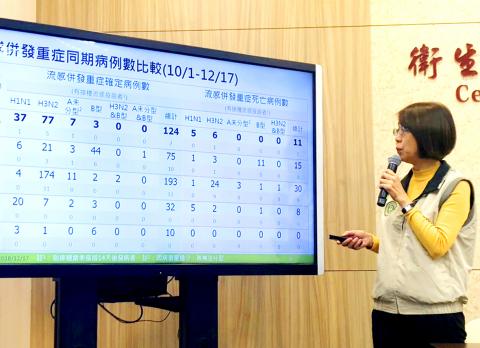A three-month-old baby was last week confirmed to have serious flu complications, the youngest person this flu season, the Centers for Disease Control (CDC) said yesterday.
A total of 61,628 flu-like illness cases, including 25 with serious complications, were reported at clinics and hospitals nationwide last week, CDC Epidemic Intelligence Center Director Liu Ting-ping (劉定萍) said in a weekly national disease monitoring report.
A total of 124 cases with serious complications have been reported this flu season, which started on Oct. 1, she said, adding that 77 of them were influenza A virus subtype H3N2 infections.

Photo: CNA
Eleven flu-related deaths have been confirmed this flu season, of which six were caused by the H3N2 strain and five by influenza A virus subtype H1N1, she added.
The ages of the 25 people with serious flu complications reported last week ranged from three months to 91 years old, CDC physician Lin Yung-ching (林詠青) said, adding that 23 of them had not been vaccinated.
Two of them were younger than six months, he said, adding that as children younger than six months cannot receive a flu vaccine, parents and nursery staff should get vaccinated and practice good personal hygiene to protect the infants.
Two of the people were pregnant, Lin said, adding that the vaccination rate for pregnant women is relatively low, as many believe that getting a flu shot during pregnancy might harm the fetus.
However, studies have shown that a flu vaccination protects the mother and the baby after birth, Lin said, adding that serious flu complications during pregnancy might cause fetal distress, a premature birth or a stillbirth.
The peak flu season is expected to arrive in two weeks, CDC Deputy Director-General Chuang Jen-hsiang (莊人祥) said, urging people to get vaccinated as soon as possible and to avoid crowded places with poor ventilation.
More than 4.93 million government-funded flu vaccines had been administered as of Sunday, and about 189,000 vaccines for adults and 72,000 vaccines for children aged six months to three years remain in stock, Chuang said.
Some cities and counties have changed where government-funded flu shots are administered, so people should check the Web site of the CDC or their local health department, or call by telephone to locate them, he added.

Taiwanese scientists have engineered plants that can capture about 50 percent more carbon dioxide and produce more than twice as many seeds as unmodified plants, a breakthrough they hope could one day help mitigate global warming and grow more food staples such as rice. If applied to major food crops, the new system could cut carbon emissions and raise yields “without additional equipment or labor costs,” Academia Sinica researcher and lead author the study Lu Kuan-jen (呂冠箴) said. Academia Sinica president James Liao (廖俊智) said that as humans emit 9.6 billion tonnes of carbon dioxide compared with the 220 billion tonnes absorbed

The Taipei Mass Rapid Transit (MRT) Wanda-Zhonghe Line is 81.7 percent complete, with public opening targeted for the end of 2027, New Taipei City Mayor Hou You-yi (侯友宜) said today. Surrounding roads are to be open to the public by the end of next year, Hou said during an inspection of construction progress. The 9.5km line, featuring nine underground stations and one depot, is expected to connect Chiang Kai-shek Memorial Hall Station to Chukuang Station in New Taipei City’s Jhonghe District (中和). All 18 tunnels for the line are complete, while the main structures of the stations and depot are mostly finished, he

Taipei is to implement widespread road closures around Taipei 101 on Friday to make way for large crowds during the Double Ten National Day celebration, the Taipei Department of Transportation said. A four-minute fireworks display is to be launched from the skyscraper, along with a performance by 500 drones flying in formation above the nearby Nanshan A21 site, starting at 10pm. Vehicle restrictions would occur in phases, they said. From 5pm to 9pm, inner lanes of Songshou Road between Taipei City Hall and Taipei 101 are to be closed, with only the outer lanes remaining open. Between 9pm and 9:40pm, the section is

China’s plan to deploy a new hypersonic ballistic missile at a Chinese People’s Liberation Army Rocket Force (PLARF) base near Taiwan likely targets US airbases and ships in the western Pacific, but it would also present new threats to Taiwan, defense experts said. The New York Times — citing a US Department of Defense report from last year on China’s military power — on Monday reported in an article titled “The missiles threatening Taiwan” that China has stockpiled 3,500 missiles, 1.5 times more than four years earlier. Although it is unclear how many of those missiles were targeting Taiwan, the newspaper reported